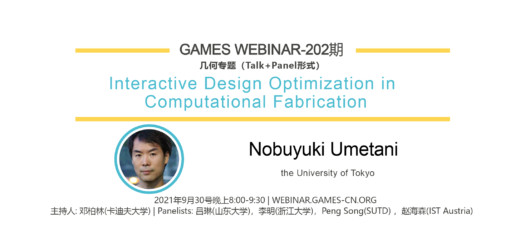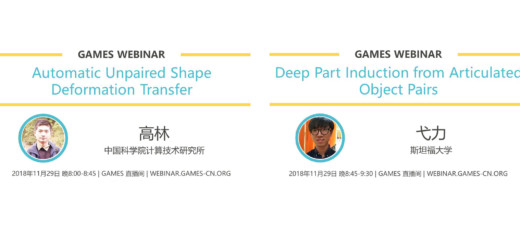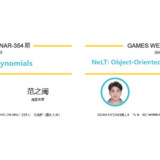GAMES Webinar 2020 – 148期(CVPR专题) | Zhiqin Chen(Simon Fraser University), Jiabao Lei(South China University of Technology), Boyang Deng(Google Brain)



【GAMES Webinar 2020-148期】(CVPR专题)
报告嘉宾1:Zhiqin Chen(Simon Fraser University)
报告时间:2020年7月23号星期四晚上8:00 – 8:30(北京时间)
报告题目:BSP-Net: Generating Compact Meshes via Binary Space Partitioning
报告摘要:
Inspired by classical Binary Space Partitioning (BSP) data structures from computer graphics, we introduce a network architecture that learns to represent a 3D shape via convex decomposition. The network is trained to reconstruct a shape using a set of convexes obtained from a BSP-tree built on a set of planes. The convexes inferred by BSP-Net can be easily extracted to form a polygon mesh, without any need for iso-surfacing. The generated meshes are compact (i.e., low-poly) and well suited to represent sharp geometry; they are guaranteed to be watertight and can be easily parameterized. We also show that the reconstruction quality by BSP-Net is competitive with state-of-the-art methods while using much fewer primitives.
讲者简介:
Zhiqin Chen is a first-year Ph.D. student at Simon Fraser University, under the supervision of Prof. Hao (Richard) Zhang. He received his Master’s degree from Simon Fraser University in 2019, and Bachelor’s degree from Shanghai Jiao Tong University in 2017. His research interest is computer graphics with specialty in geometric modeling and machine learning.
讲者个人主页: https://czq142857.github.io
报告嘉宾2: Jiabao Lei(South China University of Technology)
报告时间:2020年7月23号星期四晚上8:30 – 9:00(北京时间)
报告题目:Analytic Marching: An Analytic Meshing Solution from Deep Implicit Surface Networks
报告摘要:
We study a problem of learning surface mesh via implicit functions in an emerging field of deep learning surface reconstruction, where implicit functions are popularly implemented as multi-layer perceptrons (MLPs) with rectified linear units (ReLU). To achieve meshing from learned implicit functions, existing methods adopt the de-facto standard algorithm of marching cubes; while promising, they suffer from loss of precision learned in the MLPs, due to the discretization nature of marching cubes. Motivated by the knowledge that a ReLU based MLP partitions its input space into a number of linear regions, we identify from these regions analytic cells and analytic faces that are associated with zerolevel isosurface of the implicit function, and characterize the theoretical conditions under which the identified analytic faces are guaranteed to connect and form a closed, piecewise planar surface. Based on our theorem, we propose a naturally parallelizable algorithm of analytic marching, which marches among analytic cells to exactly recover the mesh captured by a learned MLP. Experiments on deep learning mesh reconstruction verify the advantages of our algorithm over existing ones.
讲者简介:
Jiabao Lei is currently a first-year graduate student at south china university of technology supervised by Prof. Kui Jia in the geometric perception and intelligence research lab. He is interested in 3D surface reconstruction, computer vision and computer graphics. And this is his first work on 3D surface reconstruction.
报告嘉宾3: Boyang Deng(Google Brain)
报告时间:2020年7月23号星期四晚上9:00 – 9:30(北京时间)
报告题目:CvxNet: Learnable Convex Decomposition
报告摘要:
Any solid object can be decomposed into a collection of convex polytopes (in short, convexes). When a small number of convexes are used, such a decomposition can be thought of as a piece-wise approximation of the geometry. This decomposition is fundamental in computer graphics, where it provides one of the most common ways to approximate geometry, for example, in real-time physics simulation. A convex object also has the property of being simultaneously an explicit and implicit representation: one can interpret it explicitly as a mesh derived by computing the vertices of a convex hull, or implicitly as the collection of half-space constraints or support functions. Their implicit representation makes them particularly well suited for neural network training, as they abstract away from the topology of the geometry they need to represent. However, at testing time, convexes can also generate explicit representations – polygonal meshes – which can then be used in any downstream application. We introduce a network architecture to represent a low dimensional family of convexes. This family is automatically derived via an auto-encoding process. We investigate the applications of this architecture including automatic convex decomposition, image to 3D reconstruction, and part-based shape retrieval.
讲者简介:
Boyang Deng is a researcher from Google Brain working with Geoffrey Hinton. His research is focused on bridging computer vision and computer graphics using differentiable operators. Specifically, he has been working on differentiable shape representation, differentiable rendering, and neural rendering. He is also a team member of TensorFlow-Graphics, a differentiable graphics library in TensorFlow. He obtained his Bachelor’s degree from Beihang University in 2018. He has multiple publications in CVPR/ECCV/TPAMI.
主持人简介:
GAMES主页的“使用教程”中有 “如何观看GAMES Webinar直播?”及“如何加入GAMES微信群?”的信息;
GAMES主页的“资源分享”有往届的直播讲座的视频及PPT等。
观看直播的链接:http://webinar.games-cn.org











